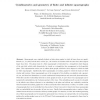Free Online Productivity Tools
i2Speak
i2Symbol
i2OCR
iTex2Img
iWeb2Print
iWeb2Shot
i2Type
iPdf2Split
iPdf2Merge
i2Bopomofo
i2Arabic
i2Style
i2Image
i2PDF
iLatex2Rtf
Sci2ools
SIAMDM
2010
2010
Combinatorics and Geometry of Finite and Infinite Squaregraphs
Abstract. Squaregraphs were originally defined as finite plane graphs in which all inner faces are quadrilaterals (i.e., 4-cycles) and all inner vertices (i.e., the vertices not incident with the outer face) have degrees larger than three. The planar dual of a finite squaregraph is determined by a triangle-free chord diagram of the unit disk, which could alternatively be viewed as a triangle-free line arrangement in the hyperbolic plane. This representation carries over to infinite plane graphs with finite vertex degrees in which the balls are finite squaregraphs. Algebraically, finite squaregraphs are median graphs for which the duals are finite circular split systems. Hence squaregraphs are at the crosspoint of two dualities, an algebraic and a geometric one, and thus lend themselves to several combinatorial interpretations and structural characterizations. With these and the 5-colorability theorem for circle graphs at hand, we prove that every squaregraph can be isometrically embedd...
| Added | 21 May 2011 |
| Updated | 21 May 2011 |
| Type | Journal |
| Year | 2010 |
| Where | SIAMDM |
| Authors | Hans-Jürgen Bandelt, Victor Chepoi, David Eppstein |
Comments (0)

